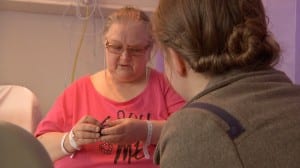Sharing memories through objects
By Betsy Lewis-Holmes, on 22 July 2013
Blog entry by Stacy Bowe. Stacy is studying for her MA in Managing Archaeological Sites and has been volunteering on the project since May 2013. Here she tells us more about the Community Curation project.
After I had been conducting Touching Heritage sessions for a couple of weeks, I accompanied two of my other facilitators to a sheltered housing centre for a new type of session, where participants were invited to bring out an object or two of their own to share.
Sitting on the table was a worn leather journal that immediately attracted my attention. The cheerful owner explained that this tome was actually the diary of her great grandfather, written when he was a sailor in the British navy, stationed in the Pacific during the later years of the nineteenth century. She carefully handed it to me, and as she continued discussing the diary’s attributes, I quietly examined some of the entries.
In striking penmanship, the eagerness of the diary’s author was palpable. All events from the profound to the prosaic were recorded. His descriptions and judgements exuded a youthful and sometimes juvenile sparkle to the diary’s contents, and it suddenly struck me that the author was only eighteen at the time of this incredibly daunting experience. The entries mingled with a bit of horror, amusement, and excitement. Whether he understood or not, the author was discovering first-hand the reasons why Europe was becoming obsessed with all things Asian. Picturing myself back at eighteen, I smiled to think at what I would have potentially written in the same situation. I empathized with his wonder and bewilderment. Her grandfather may have been long gone from this world, but as I handed the diary back to the participant, I knew we had shared an intimate moment together across history.
 Close
Close







